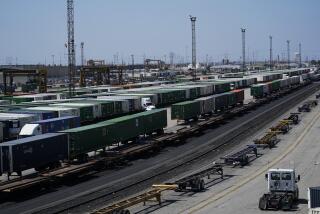New Power Plants May Get Leeway on Smog
- Share via
The South Coast Air Quality Management District is expected to vote today on a plan that would allow major new power plants across Southern California to buy air pollution credits designed for hospitals, fire stations, sewage plants and other essential service providers.
The AQMD staff predicts that under the program, an additional three tons of smog-forming pollutants could be emitted each day by plants proposed in Industry, Carson, Vernon, Victorville, Palmdale and Romoland, an Inland Empire community.
BP, Edison Mission Energy, the city of Vernon and other plant applicants would pay a per-pound fee for the extra smog they would be allowed to emit. Those prices would be set high -- $54,000 per pound for particulate soot, for instance -- but would be less than the $90,000 per pound currently charged under an open-market system. The fee also would need to be paid only once as opposed to annually on the open market.
Funds from the program would be used for other pollution-reduction plans, such as replacing older, diesel-powered school buses with cleaner ones, they said, and any increase in pollution would be gradually offset.
Environmental and community justice groups sharply criticized the proposal, saying that there would be a net gain in air pollution across the Southland, and that poorer communities where the plants would be built would be hit hardest in a region already badly out of compliance with federal clean air laws. They said renewable energy and conservation should be used instead.
“It’s a handout to the power plant companies by air regulators that are supposed to be protecting air quality, but what they’re really doing is engaging in corporate welfare.... It means that we’re going to have more air pollution, not less, and that we’re even further away from reaching the federal air quality standards,” said Joe Lyou of California Environmental Rights Alliance, a Los Angeles-based group that is one of several objecting to the plan.
The cities where the plants are proposed, Lyou said, “are communities of color and low-income communities that are already overwhelmed with all kinds of pollution.”
But executives with the AQMD and power plant proponents say the exemptions, which were granted once before after the 2001 energy crisis, are necessary because new, cleaner electricity is badly needed to prevent more blackouts. They say there are almost no emissions credits available in a similar open-market program designed for commercial companies in the Southland.
“Without this program ... these new, clean technology plants will not get built,” said AQMD Executive Director Barry Wallerstein.
The AQMD staff pointed to forecasts by California’s Independent System Operator predicting the entire state would need 3,248 additional megawatts by 2010 to avoid severe Stage 3 blackouts. The new projects proposed for Southern California would generate just under 3,500 megawatts. Wallerstein said he feared that if the new plants were not built, it could lead to efforts to scrap the emissions-offset program completely and permanently weaken clean air laws.
He said the reserve program for essential service providers was the only legal avenue to create more credits for commercial plants.
Far from cutting into the emission credit supply needed for new hospitals, fire stations and other essential services, Wallerstein added, it would guarantee that public health and safety needs could be met while clean air standards were upheld.
“When people are out of electricity, there is a host of public safety problems that occur. So if the choice is between people having no traffic lights and having traffic accidents, or a patient not having access to oxygen because he needs electricity for it, in the past the governor and other elected officials have said you have to have more air pollution,” Wallerstein said. “So from our perspective, it’s better to make sure you have enough clean power and electricity to provide the necessities.”
Bob Wyman, an attorney with Latham & Watkins who along with another partner is representing some of the power plant applicants, said, “These plants being proposed are the cleanest plants in the world.... I think the opponents are misguided.”
He said the construction of new, cleaner power plants would also reduce the use of older, less-efficient and dirtier power plants during non-peak hours.
If the regulatory change is passed, it would apply to proposed projects between 2005 and 2008 and would also need to be approved by the California Air Resources Board and U.S. Environmental Protection Agency. The EPA approval could be done retroactively, Wyman said.
A public hearing will be held before the vote. The meeting begins at 9 a.m. at AQMD headquarters at 21865 Copley Drive in Diamond Bar.
*
More to Read
Sign up for Essential California
The most important California stories and recommendations in your inbox every morning.
You may occasionally receive promotional content from the Los Angeles Times.










